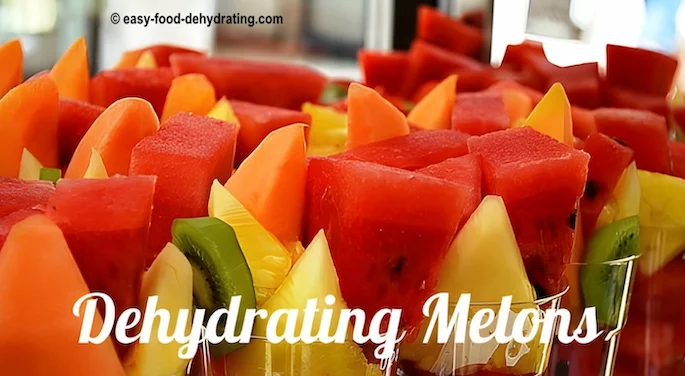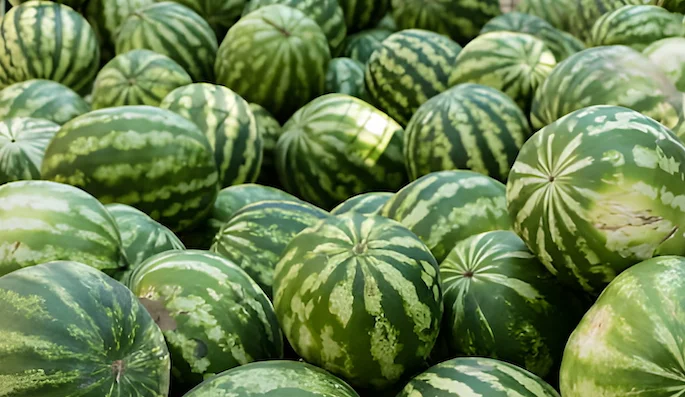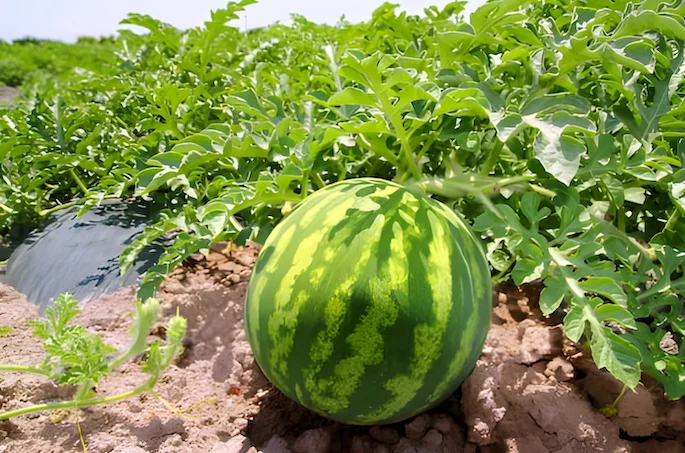What We Mean by “Dehydrate”
Here at Easy Food Dehydrating, “dehydrate” always means using an electric food dehydrator — the easy, reliable way to dry food at home.
- Home
- Dehydrating Fruits: Step-by-Step Guides by Type
- How to Dehydrate Melons
How to Dehydrate Melons:
Enjoy Watermelon & Honeydew Anytime

There’s something magical about enjoying melon in the middle of summer - juicy, sweet, and refreshing. But what if you could keep that taste long after melon season ends?
✅ Quick Answer: How do you dehydrate melons?
To dehydrate melons, peel and seed them, slice into ¼–½ inch pieces, and dry at 125°F–135°F for 8–20 hours. Rotate trays for even drying. Finished melon should be crisp or pliable—perfect for snacking or long-term storage.
By dehydrating honeydew and watermelon, you can enjoy light, crunchy snacks or long-lasting storage options anytime.
It’s easier than you think, and the process works for most melons—so let’s dive in!

Why Dehydrating Melons Is Worth It
Most people think of watermelon and honeydew as fruits you can only enjoy fresh, juicy, and messy. But when you dehydrate melons, you unlock a whole new way to enjoy them. The concentrated sweetness tastes almost like candy - without the added sugar.
Dried melon is lightweight, portable, and perfect for hiking, school lunches, or quick snacks on the go. Plus, when stored properly, it lasts months instead of just days in the fridge. Dehydrating melons isn’t just about preserving fruit - it’s about giving yourself summer sweetness any time of year!
Nutrition Boost: What Melons Really Offer
Honeydew
VITAMINS: Honeydew melon is rich in Vitamin A and Folate, followed by Vitamin C, and Vitamin K.
MINERALS: Honeydews are loaded with Potassium, followed by Phosphorous and Magnesium.
Honeydew melon is a good source of Omega-3 and Omega-6 fatty acids.
Watermelon
VITAMINS: Watermelons also have a great Vitamin A level, followed by Vitamin C, Folate, and Choline.
MINERALS: Phosphorous, Magnesium, Calcium, Potassium, and Fluoride!
Watermelon is a good source of carbohydrates too, and Omega-6 fatty acids.
Secrets to Choosing the Sweetest Watermelon
 Midjourney image
Midjourney imageThere are a few ways to tell if your watermelon is ripe and ready to eat.
First, you'll want to make sure the fruit is firm to the touch.
Also, take a sniff near the stem end of the watermelon - it should smell sweet and fragrant.
Lastly, give the melon a gentle thump - if it sounds hollow, it's ready to eat!
The #1 Trick to Know If Watermelon Is Ripe
 A pile of picked watermelons
A pile of picked watermelonsAnother way to check to see if your watermelon is ripe, look for a white patch on it.
The white patch means it's been sitting in the field long enough to have created that patch "where the sun don't shine.".. That means it wasn't plucked too soon!
Scroll down to the bottom of the page to learn what to do with your melon seeds...
don't toss 'em, here's how to roast 'em!
Scroll down to the bottom of the page to
learn what to do with your melon seeds...
don't toss 'em,
here's how
to roast 'em!
Honeydew Ripeness Test: Does Yours Pass the Squeak?
For honeydew ripeness testing, clean the oil off your thumb and rub it across the honeydew's surface and if it squeaks, you're good!
Also, if the skin is a pale white, the melon probably would be better if it was a little more on the yellow side before eating.
Honeydew and watermelons are very easy to dehydrate—see the instructions below—and don't forget to roast the seeds (instructions on how to roast melon seeds are coming up!)
Step-by-Step: How to Dehydrate Melons Like a Pro
Are you ready to get started dehydrating melons? Here's how to do it:
- Remove the skin and seeds from your honeydew or watermelon
- Slice the fruit into 1/2" thick slices and arrange on your food dehydrator trays
- Turn on your food dehydrator and set the temperature between 125°F and 135°F (or per your food dehydrator's instructions).
💡 Tip: Outside the U.S.? Most dehydrating temps here are listed in Fahrenheit - use our quick converter to see the Celsius equivalent for your machine.
- Drying time: between 8-20 hours. They can either be pliable, or crisp to your liking, but for long-term storage, the dryer the better!
- Please remember to rotate your dehydrator trays for even drying.
Dehydrated honeydew and watermelon, aka watermelon jerky, is a fantastic snack on its own, but it's also great for adding to trail mix, yogurt, oatmeal, and more.
The concentrated melon flavor is like a burst of summer sunshine!
Where Melons Grow Best (and Why It Matters)

Melons are a versatile fruit that can be used in sweet and savory dishes alike. If you're looking to add this tasty fruit to your garden, you'll want to make sure you have the right conditions for growing melons.
According to The Old Farmer's Almanac, melons need full sun and well-drained, fertile soil with a pH between 6.0 and 7.0.
When it comes to planting, you'll want to start your melon seeds indoors about three weeks before the last spring frost.
Once it's time to transplant the seedlings outdoors, make sure to space them 48 inches apart in rows that are 8 feet apart.
Don’t Toss Those Melon Seeds—Roast Them Instead!
NOTE: Don't toss the seeds. If you are so inclined, you can roast the seeds.
Let them dry thoroughly after giving them a good cleaning/rinse in your sieve under the kitchen faucet.
Spray the seeds first with plain cooking spray and a dash of salt.
Toss them on a cookie sheet for 15 to 20 minutes at 325°F.
💡 Tip: Outside the U.S.? Most dehydrating temps here are listed in Fahrenheit - use our quick converter to see the Celsius equivalent for your machine.
Best eaten when fully cooled.
We hope you had fun learning how to dehydrate melons and roasting their seeds!
Your Top Questions Answered: Dehydrating Melons Made Easy
How do you dehydrate watermelon?
How do you dehydrate watermelon?
Slice watermelon into ¼–½ inch pieces, remove seeds, and blot dry. Dehydrate at 125°F–135°F for 8–20 hours until pliable or crisp. Rotate trays for even drying.
Can you dehydrate watermelon in an air fryer?
Can you dehydrate watermelon in an air fryer?
Yes! Set your air fryer to its lowest setting (90°F–110°F if possible). Dry slices for 6–10 hours, flipping halfway. A dehydrator is still more efficient for larger batches.
Can you dehydrate honeydew or cantaloupe the same way?
Can you dehydrate honeydew or cantaloupe the same way?
Absolutely. Peel, seed, slice, and dehydrate with the same method as watermelon. Check for ripeness first—ripe melons make the best dried fruit.
Can you dehydrate melon in the oven?
Can you dehydrate melon in the oven?
Yes, but it’s less efficient. Set the oven to its lowest temp (usually 170°F), crack the door slightly for airflow, and dry slices for 8–12 hours.
How long does dehydrated melon last in storage?
How long does dehydrated melon last in storage?
Stored in airtight jars with oxygen absorbers, dehydrated melon can last up to 12 months. Keep it in a cool, dark place for best results.
Thanks for joining me on this sweet little journey into dehydrating melons! Whether you’re turning honeydew into chewy snacks or saving watermelon for later, the process is simple and rewarding.
And if you’re ready to expand your dried food collection, don’t miss the free 5 Dried Food Recipes You’ll Actually Love PDF below—featuring my favorites like carrot soup, minestrone, split pea soup, spicy beef jerky, and even banana cinnamon rolls. You’ll love having these ready to enjoy anytime.
Get 5 Dried Food Recipes You'll Actually Love
Here's where you can get your copy of our all new
5 Dried Food Recipes (That Actually Taste Great)
They're my all-time favorite easy dried food meals!
Get it here right now.
For Free!
Before You Go...
If you enjoyed this page, tap the ❤️ in the lower right-hand corner.
It saves this page to your Grow bookmarks so you can find it again later.
You’ll also see quick share buttons to copy the link, post to Facebook,
or save it straight to Pinterest.
















